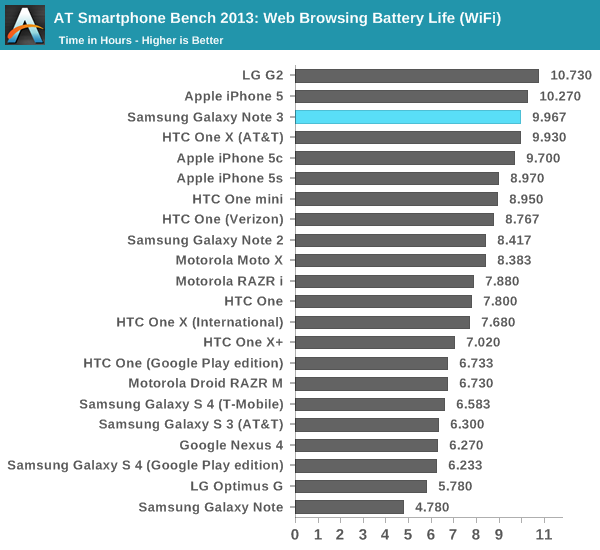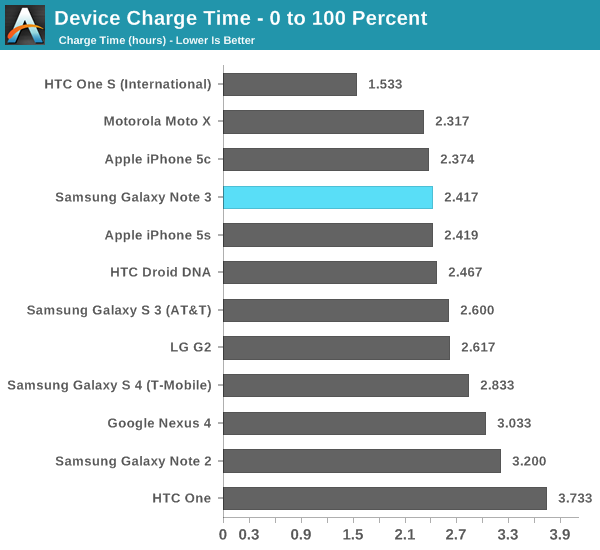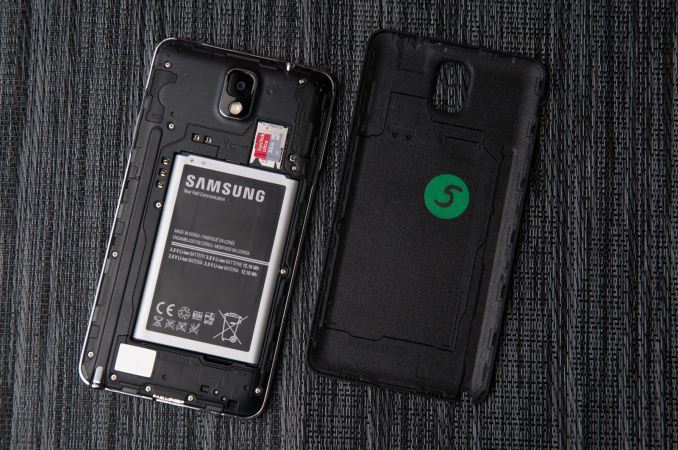Samsung Galaxy Note 3 Review
by Brian Klug on October 1, 2013 9:00 AM EST- Posted in
- Smartphones
- Samsung
- Mobile
- Android 4.3
- galaxy note 3
Battery Life
Battery life remains probably the single largest differentiator for devices lately, and of huge concern to enthusiasts and normal shoppers alike. We’ve already caught a glimpse of how well 8974 fares from a power perspective inside the LG G2, a device that posted some seriously impressive battery numbers. The Note 3 we’re looking at is also 8974 based since it’s a T-Mobile model, and thus we expect the same kind of battery life.
With this generation of Note, battery gets even larger. The Note started with a then quite large 9.25 watt hour battery, then Note 2 moved to 11.78 watt hours, and Note 3 now moves to a very large 12.16 watt hour battery with of course the newest 3.8V chemistry and all that comes along with it. Display size goes up, but those power gains are offset in other places.
After we talked about the panel self refresh features in the G2 a few people reached out and let me know that this feature has been shipping for a while in some phones, and it’s easy to check for. If we look under the display subsystem we can see that the same MIPI_CMD_PANEL type 9 is used, which refers to this type of interface.
Qualcomm HWC state: MDPVersion=500 DisplayPanel=9
define MIPI_CMD_PANEL ‘9’
Our battery life tests are unchanged and consist of a set of popular webpages that are loaded on a schedule with the display set to exactly 200 nits and repeated until the battery runs out and the device dies on both WiFi and cellular data connections. In this case that means T-Mobile LTE which is 10 MHz FDD in my market, I haven’t had a chance to run the Note 3 on HSPA+ yet, or complete the call test (which is starting to get ridiculous, and probably breaks 24 hours in the case of the Note 3).

On LTE the Note 3 does very well, coming just shy of the pack of iPhones, at just over 8 hours. Interestingly enough it’s just north of the G2s as well, which do have a smaller battery but also smaller display. The Note 3 also is the first device to ship with Qualcomm’s QFE1100 envelope tracker solution from the RF360 front end portfolio, which lowers power consumption by up to 20 percent and heat dissipation by up to 30 percent by allowing the power amplifiers to follow the desired output waveform. There’s more on that later in the cellular section.

On WiFi the Note 3 does better by 22 percent, but not the kind of huge jump I’m used to seeing between cellular and WiFi testing. This tells me the Note 3 battery life is really gated by the display, which is almost always the largest consumer of power in a device. That said the Note 3 does very well all things considered, especially in comparison to the APQ8064 (Fusion 3) phones which came before it, like SGS4. New silicon and new process inside MSM8974 definitely helps move battery life forward here with the race to sleep game.
Charging is an interesting story on the Note 3, but primarily because of what doesn’t change. The Note 3 continues to use Samsung’s tablet charging specification and charger, which has 2 amps of maximum output. The Note 3 draws 2 amps over a considerable amount of the charging curve, like other Samsung devices (in the linear part of the charge curve). USB 3.0 doesn’t change things up here quite yet with the new supported charge voltages that are coming eventually with the power delivery specification.

The Note 3 does charge faster overall compared to the SGS4 however thanks in part to the new PMIC (PM8941) which is part of the overall 8974 platform story.











302 Comments
View All Comments
Scipio Africanus - Tuesday, October 1, 2013 - link
Got to hand it to Apple's newest SoC for its phenomenal single core performance. It looks to be ahead of everyone. Non-ARM designed CPUs will be the way forward for phones here. While A15 is nice, it's power envelope is just not that great for phones. So we have Qualcomm and Apple and Samsung only using ARM designed cores. So for Android's sake, hopefully Project Denver will actually pan out so we have some more competition in this space.And I have to get this off my chest but I love my Note 2, its nearly perfect. EXCEPT for the GPU. It was at best low to midrange when it came out and now its just low end. They put in what was a really fast CPU at the time and not so great GPU.
ddriver - Tuesday, October 1, 2013 - link
It is no more than ~20% (at best, limited case scenarios) better with native code, the BS JS benchmarks should be disregarded because they use completely different engine implementations, plus everybody cheats at those like there is no tomorrow. And if for some reason you really need CPU performance on a mobile, the note 3 will actually trounce the 5s considering it has twice the cores and number-crunching tasks scale pretty much perfectly. Considering the snapdragon 800 has the same NEON width as A7, I expect the note 3 to be a good 50% better at number crunching - software rendering, audio/video editing, multiphysics and whatnot.While some might look at the snapdragon 800 for being "inferior" since it is based on arm v7, it is not like the note 4 will come with a quad core v8 chip at 2.3 Ghz, even with a v8 chip it will only be incrementally faster. No consumer device manufacturer will shoot himself in the foot by releasing something better than the bareincremental minimum needed.
That is the reason I'll be getting the note 3, here it is 25% cheaper, has a pressure sensitive stylus, huge screen, 4k video, usb 3, better GPU and all the bells and whistles of latest contemporary tech... The 5s better single thread performance is nowhere nearly enough to make up for all the advantages of the note 3.
Scipio Africanus - Tuesday, October 1, 2013 - link
I never said the 5S was superior in any way except for its single threaded performance. The Note 2 that I own today is a phenomenal device and the only thing I'd replace it with is another phablet type such as a Note 3 (or 4) or maybe an Optimus G Pro or Xperia Z. I still love having an SD card and removable battery so it looks like the Note series is it for me.The 64-bit move is just getting ready for the future IMHO in terms of memory addressing. Using that particular stat as a "feature" is just marketing. The larger number of registers in ARM V8 is nice and does help the Iphone in 64-bit application benchmarks. But most people don't have a clue what 64-bit means except that its bigger than 32.
KPOM - Wednesday, October 2, 2013 - link
The point is that Apple optimized the hardware and software for its intended purpose. No one is running a Monte Carlo analysis on a smartphone. Mobile software isn't really optimized for quad-core processors, and heat concerns limit their usefulness right now. For the purpose of running mobile software, a well-optimized dual-core processor running at a lower clock speed appears to be better than a less optimized quad-core running at a higher clock speed. It's like the Pentium 4 vs. the Pentium M and Core2 architectures. The latter two were superior even though they ran at lower clock speeds.steven75 - Wednesday, October 2, 2013 - link
Why do you trumpet things like "USB 3" when this very review shows it offers no benefits? Does reading out spec lists impress your friends or something?PxNZone - Wednesday, October 2, 2013 - link
Maybe you should check that section again about USB 3. There is an updated part. It states that the connection transfer speed is faster with Windows PC that has USB 3.0.Wolfpup - Tuesday, October 1, 2013 - link
5.7" Grrr, if Apple isn't going to release a larger phone, I wish they'd turn say the iPad mini INTO a phone. The mini seems to be pocketable, and it's obviously already very close to being a phone as it is...I'm sick of having to drool over awesome sized screens on the Android devices.
ddriver - Tuesday, October 1, 2013 - link
Seriously, all the apple fanboys b1tch about how the note series is "ridiculously, embarrassingly big" and you want to use the ipad mini as a phone :DWell, it makes sense, just like with plastic, plastic was lame and cheap-ass until the iphone 5c, and suddenly plastic became great. The ridiculous review at engadget b1tching about the note 3 plastic while praising the 5c plastic...
darkcrayon - Tuesday, October 1, 2013 - link
You realize not all plastic is the same right? And you can't even see the hole in your own example - Apple released a plastic phone as the lower end model to their metal device (something they've been doing on and off for well over a decade now).ddriver - Tuesday, October 1, 2013 - link
Lower end? It is more expensive than 99% of the phones on the market. And in this particular case, the plastic is exactly the same - POLYCARBONATE. Naturally, in the mind of an apple fanboy, the plastic on the 5c is special and magic and full of awesome...